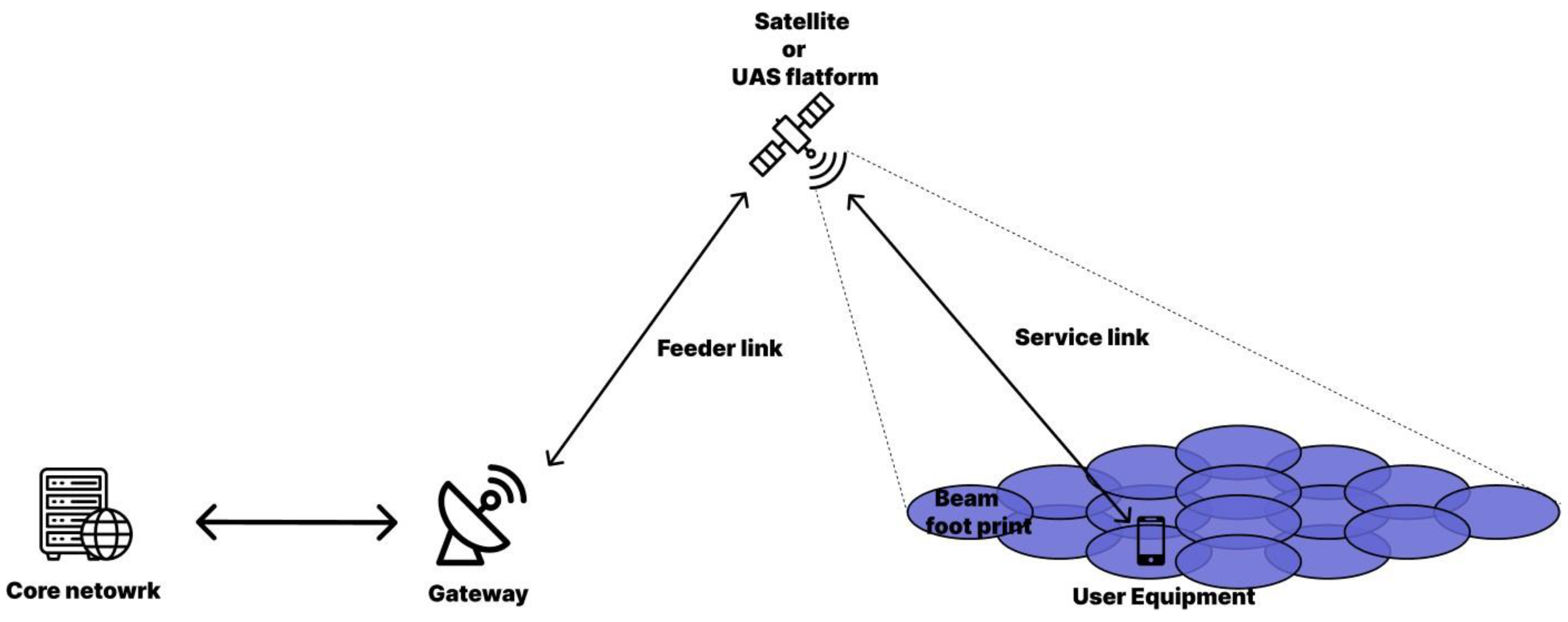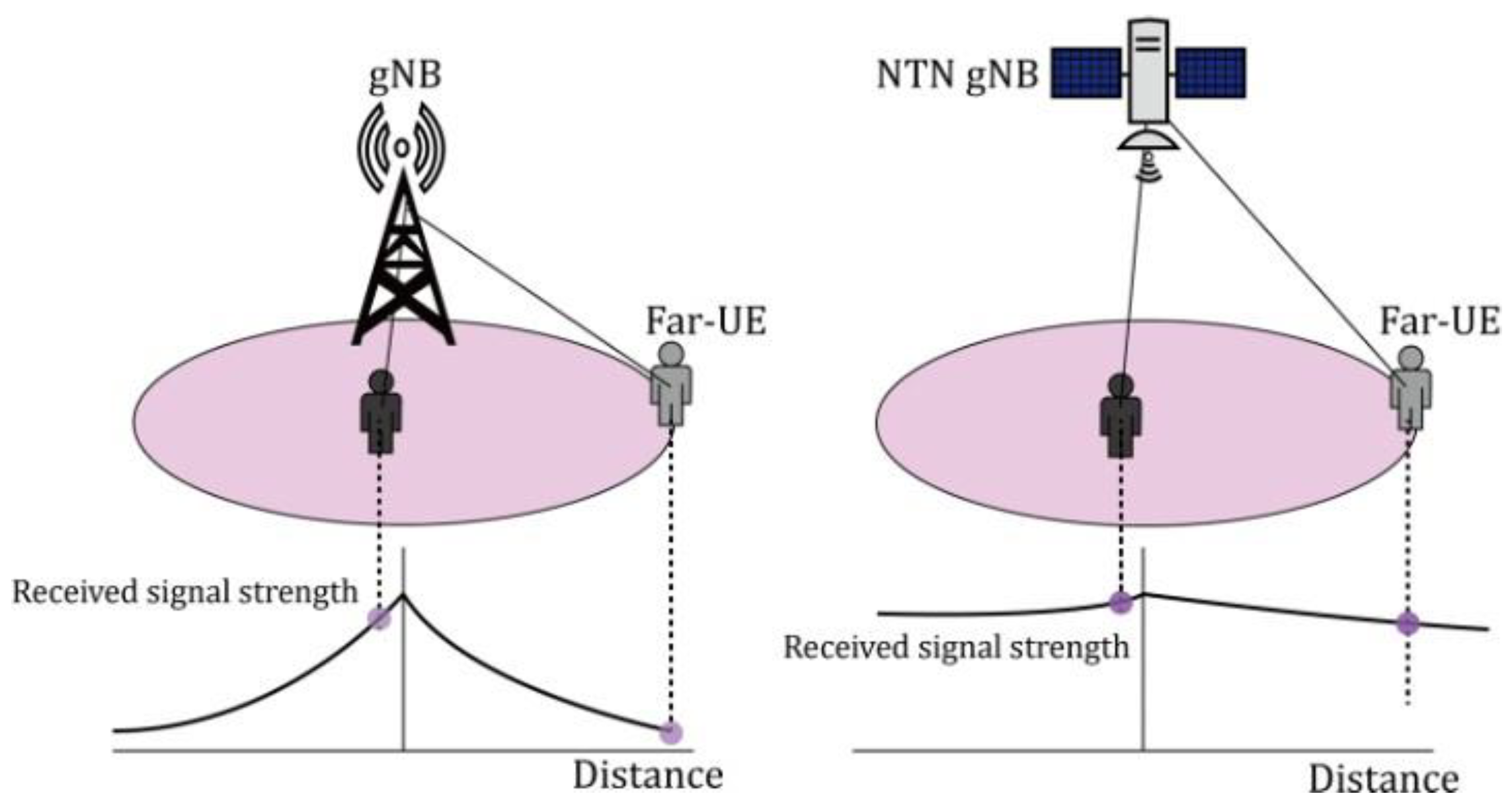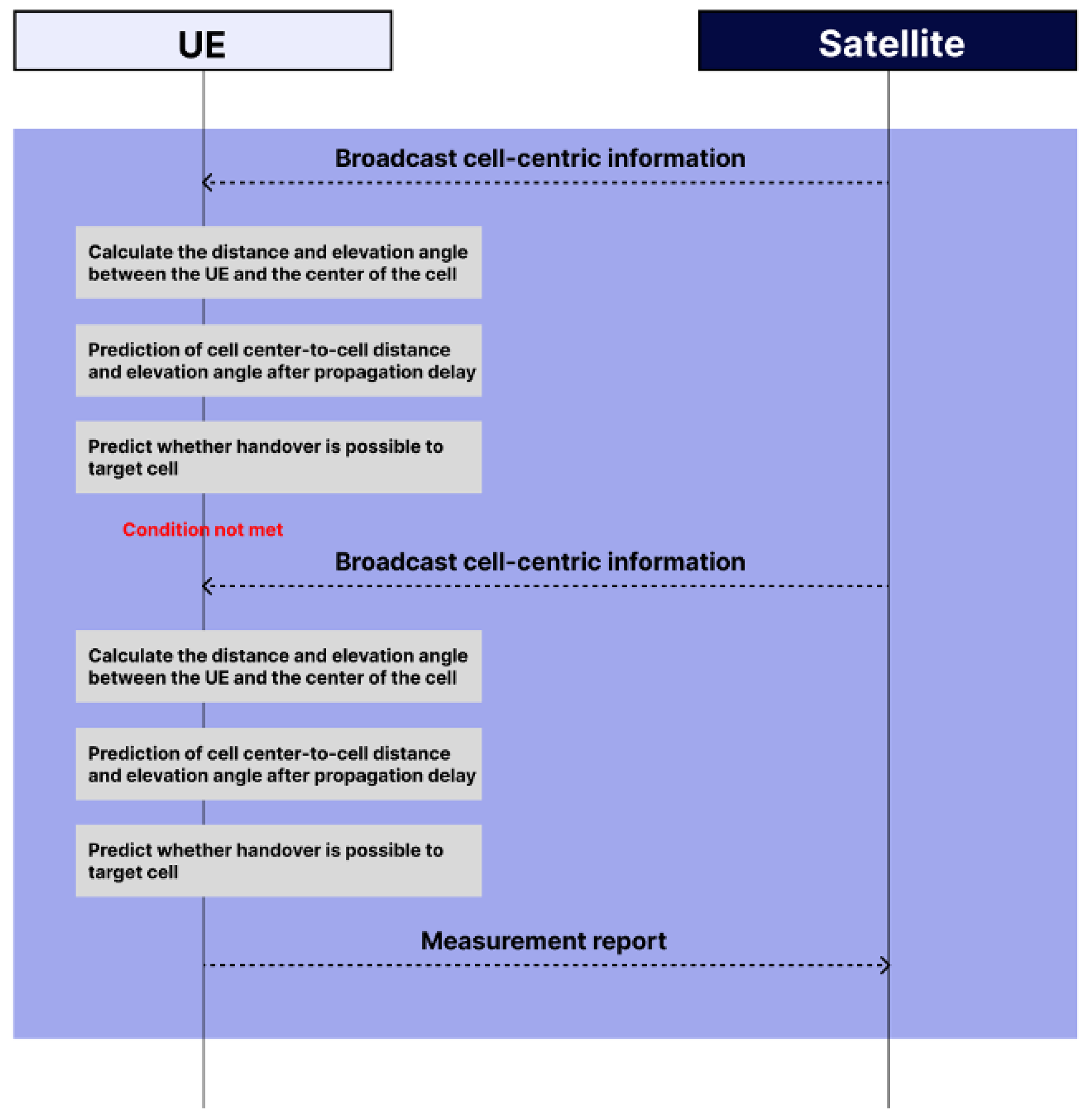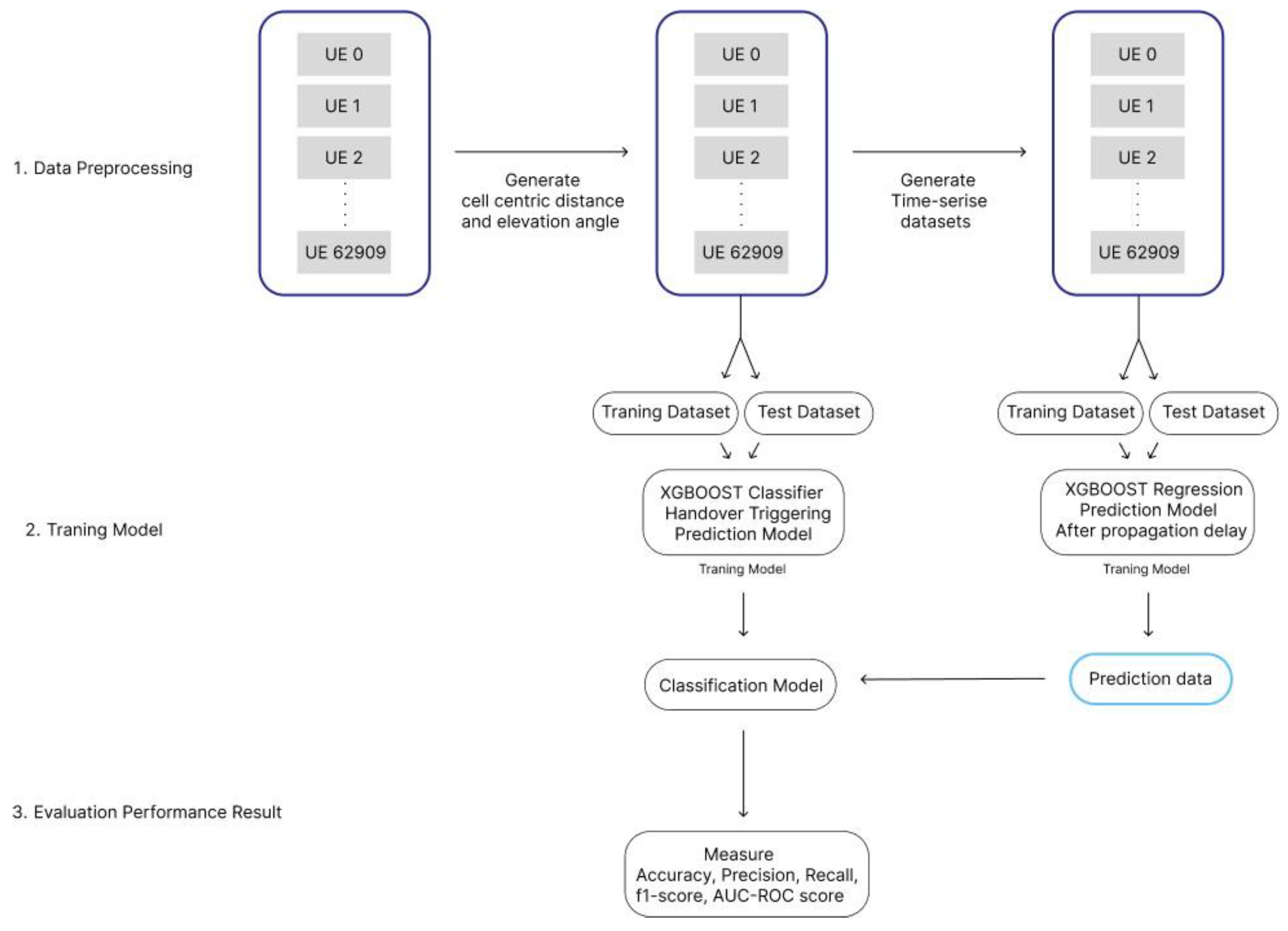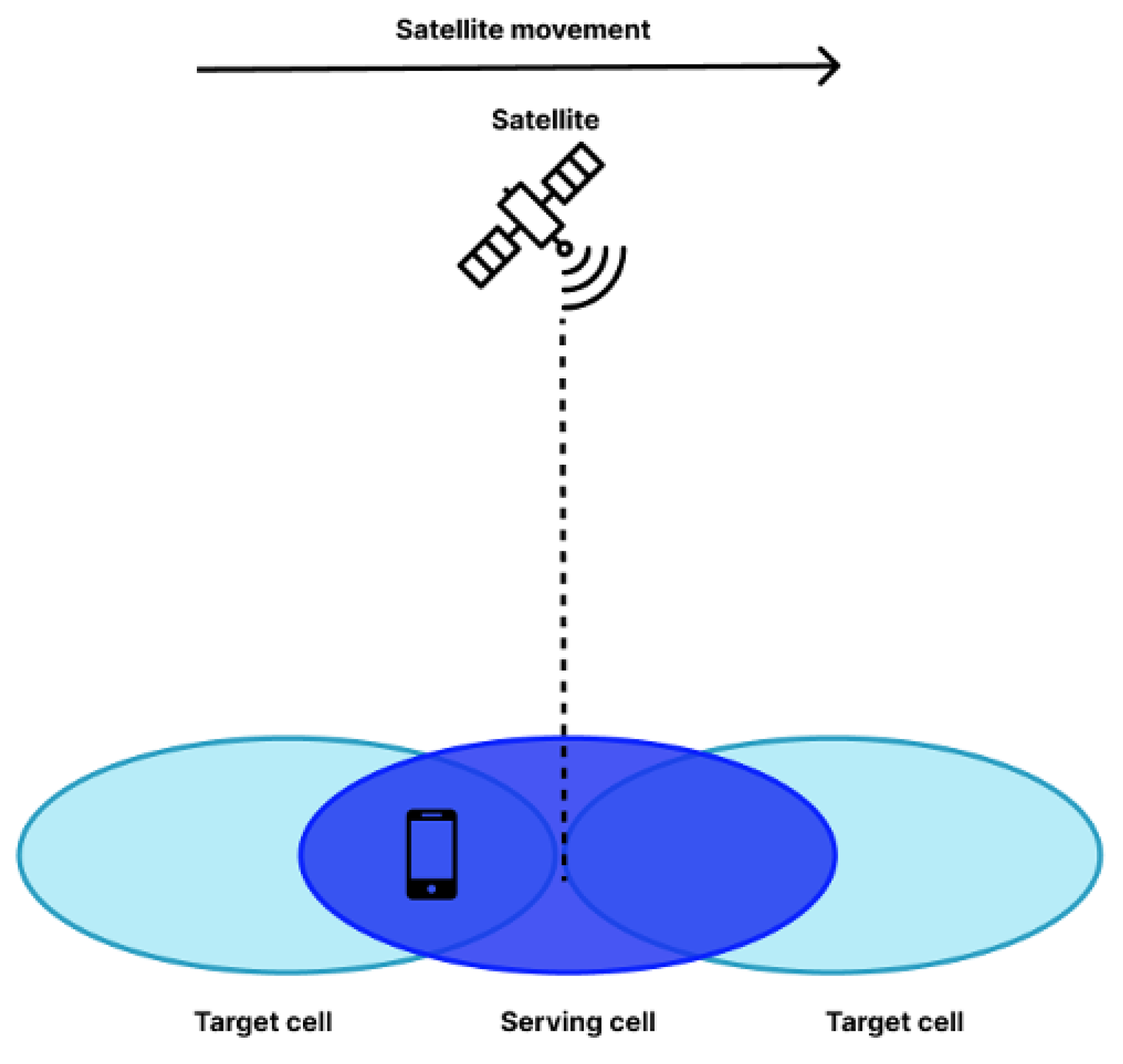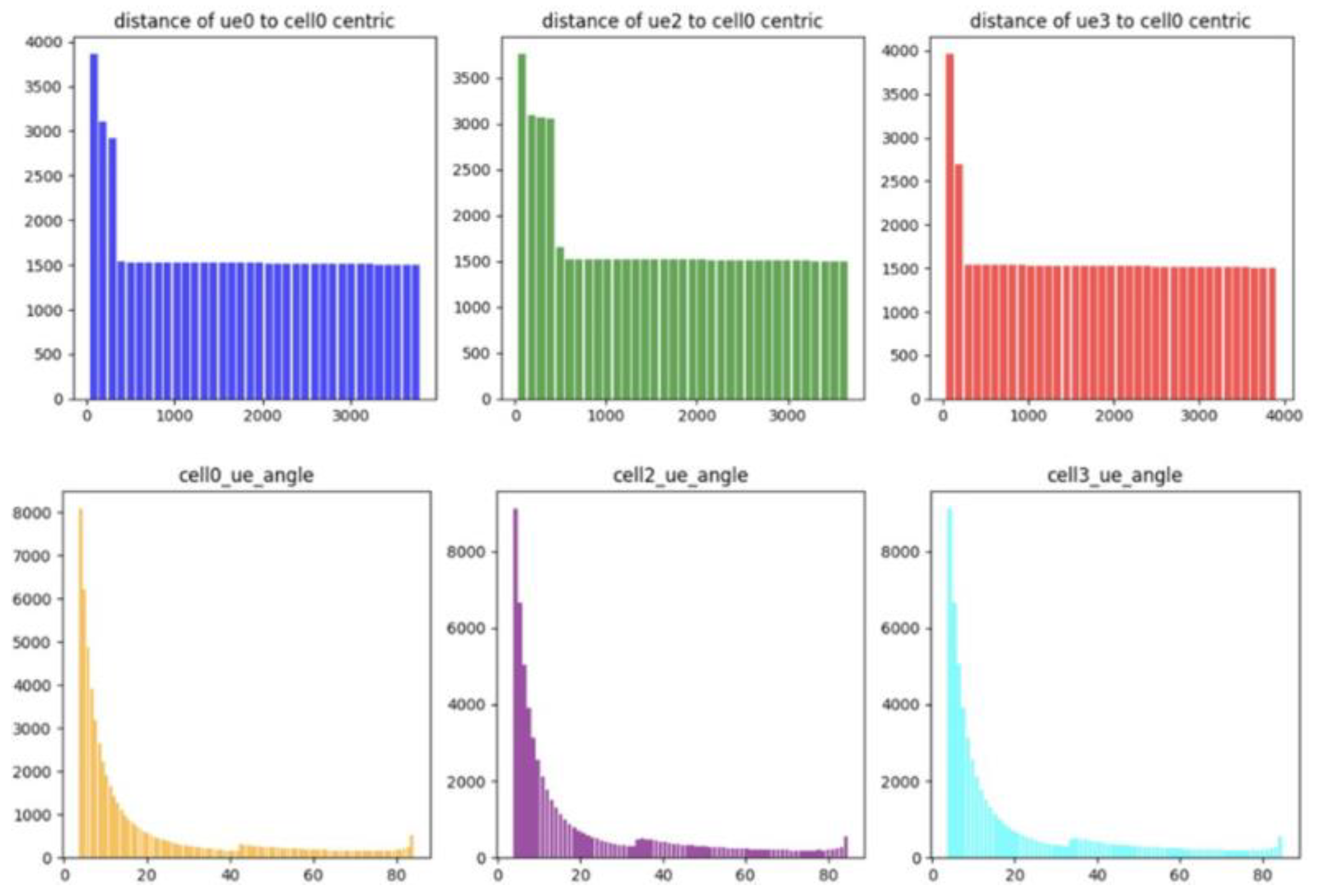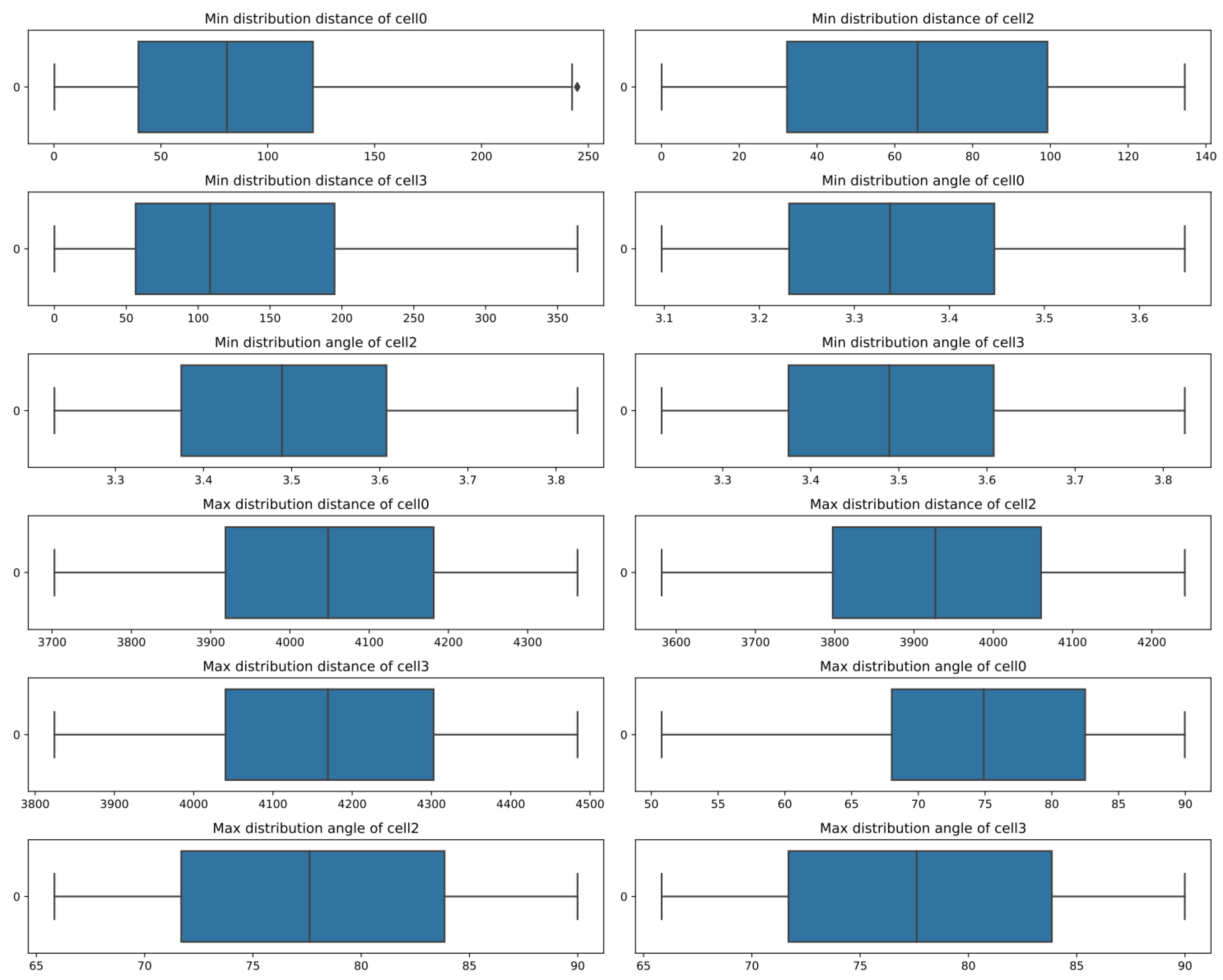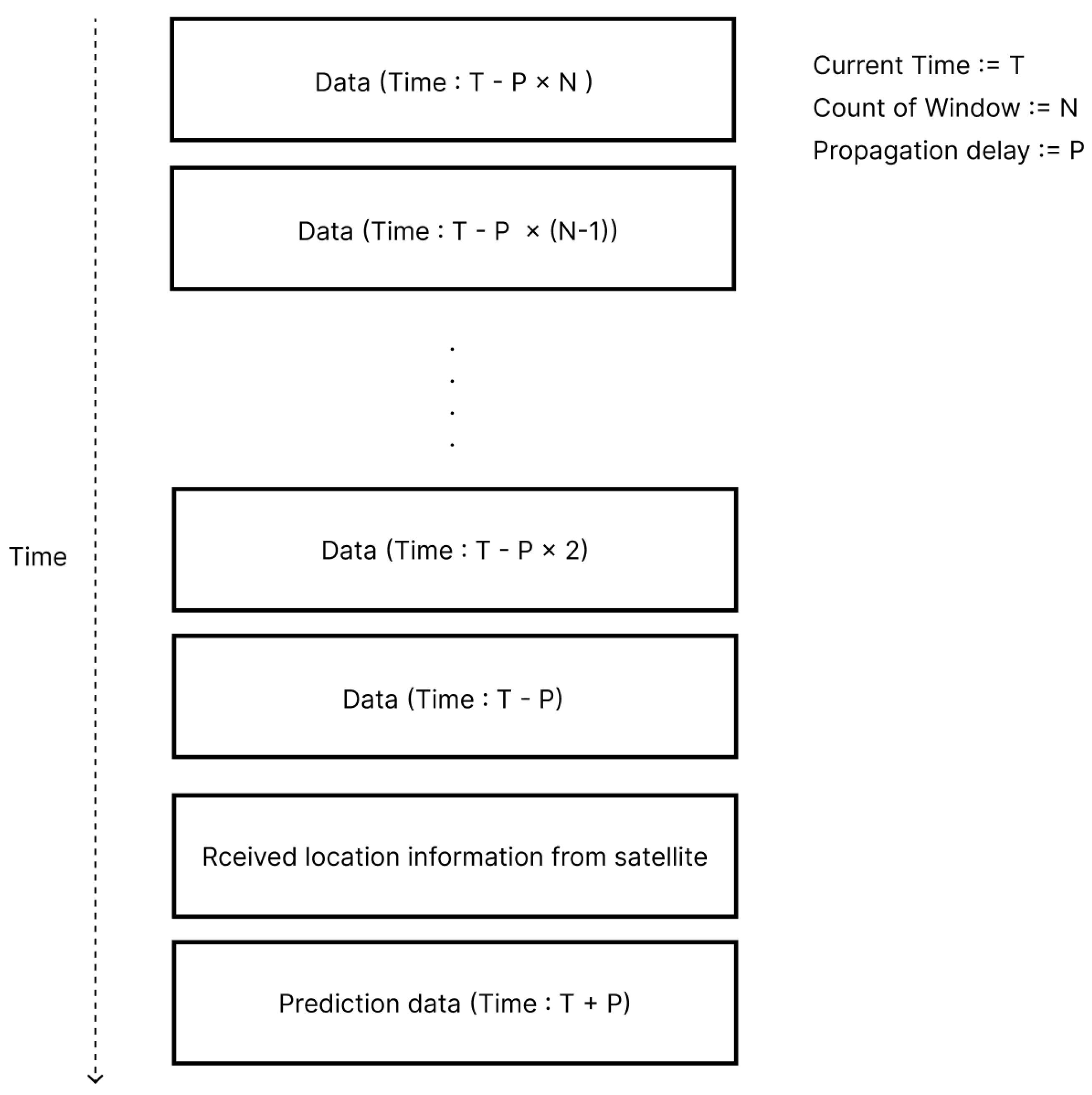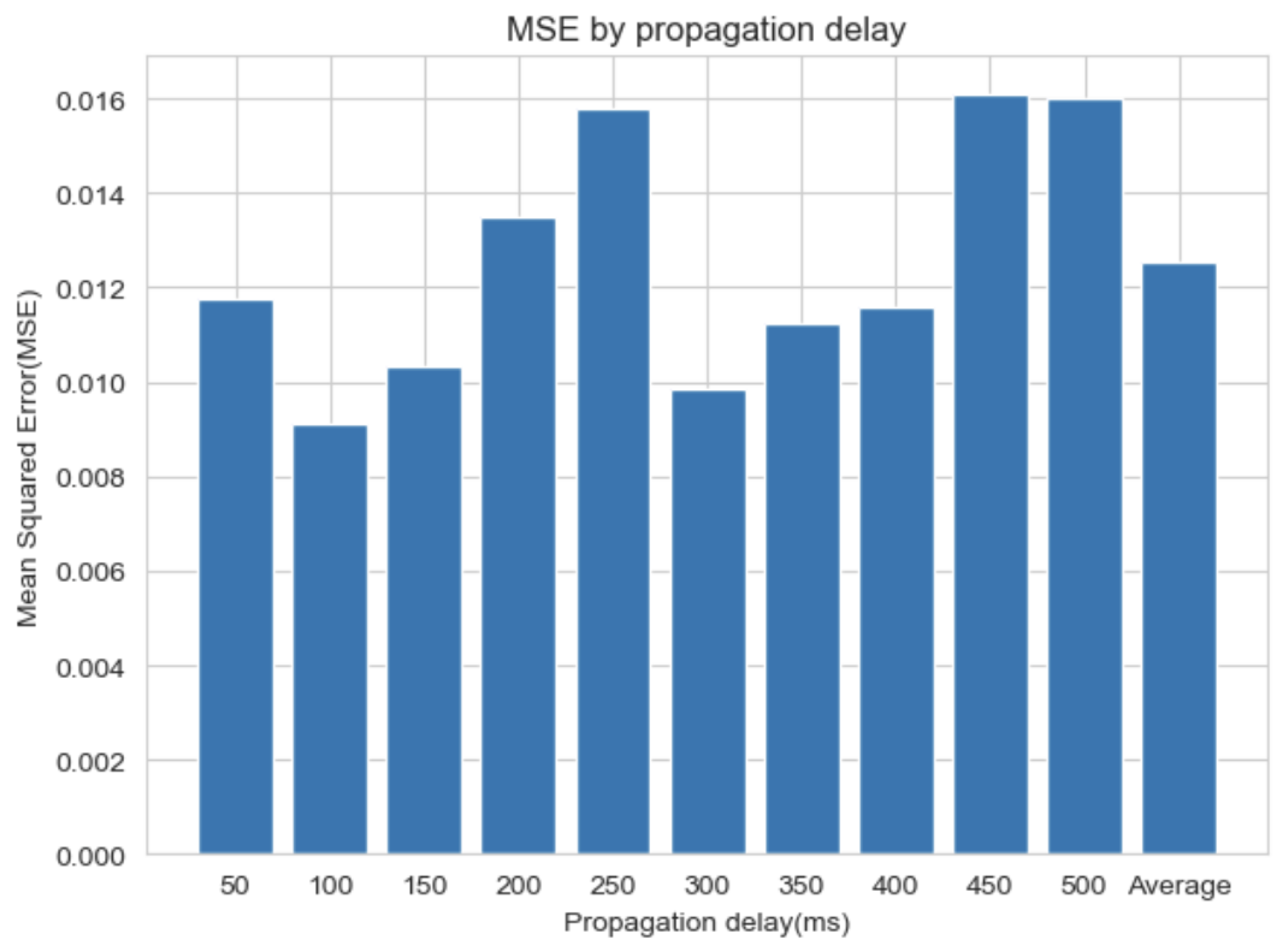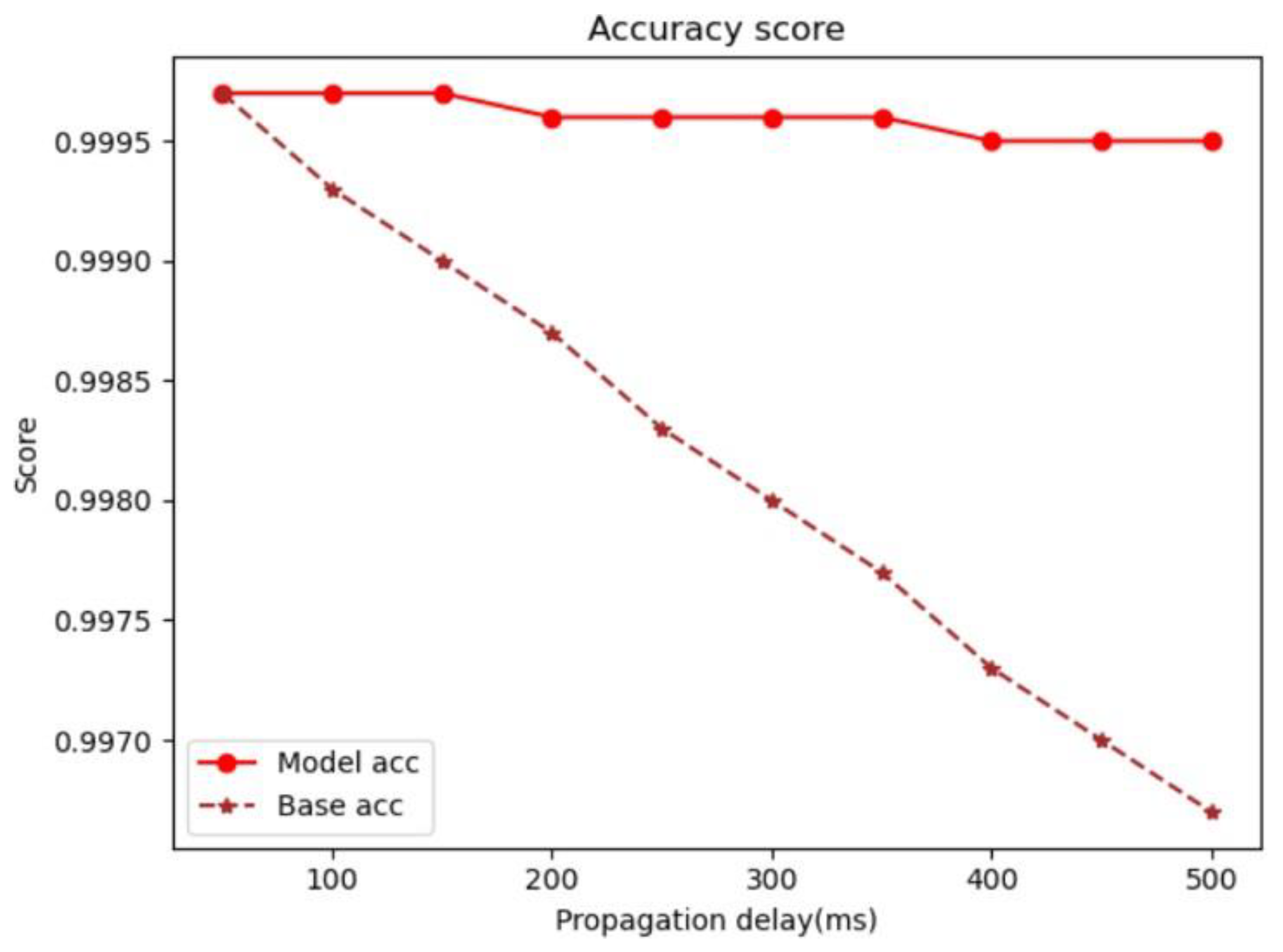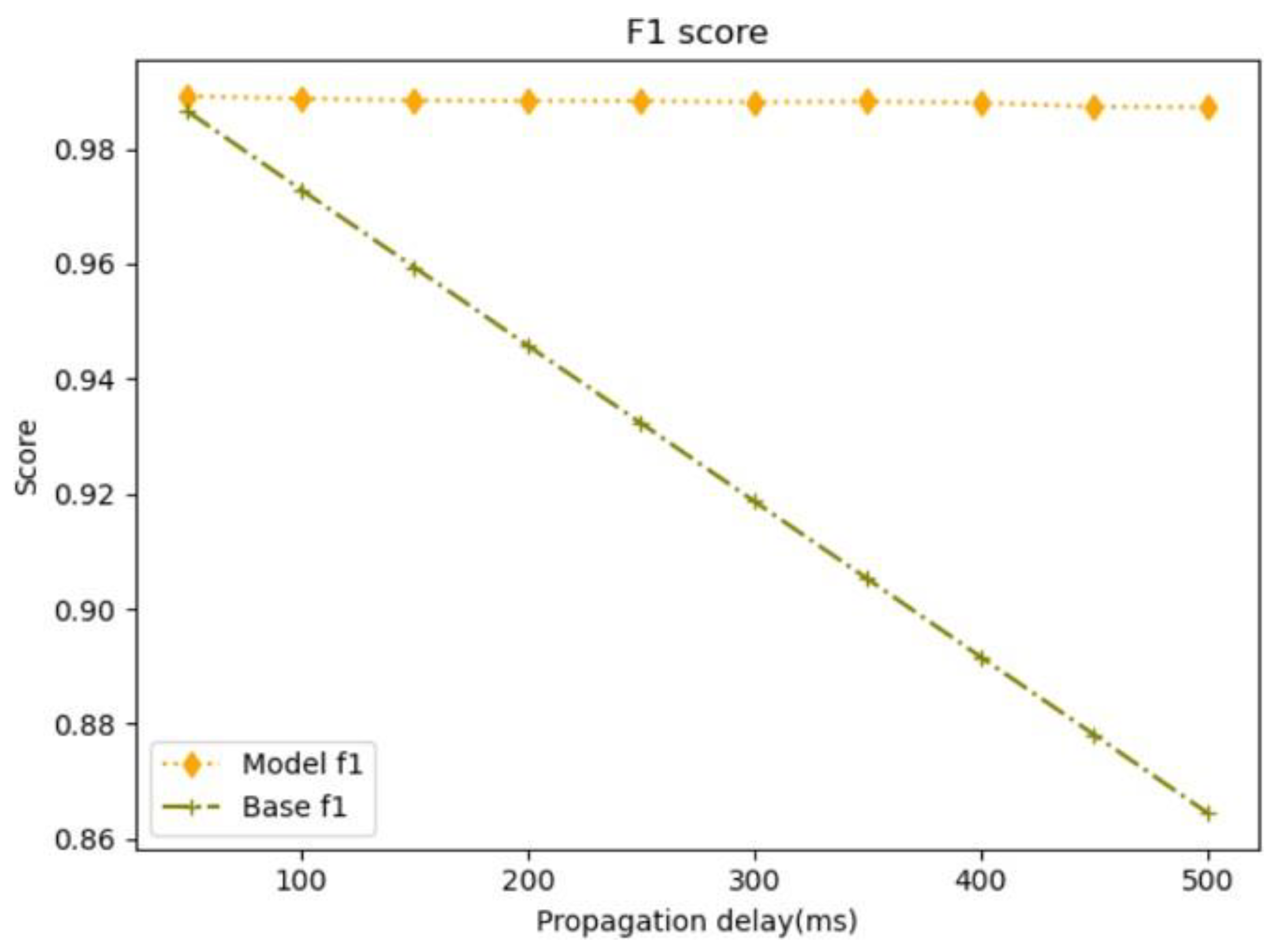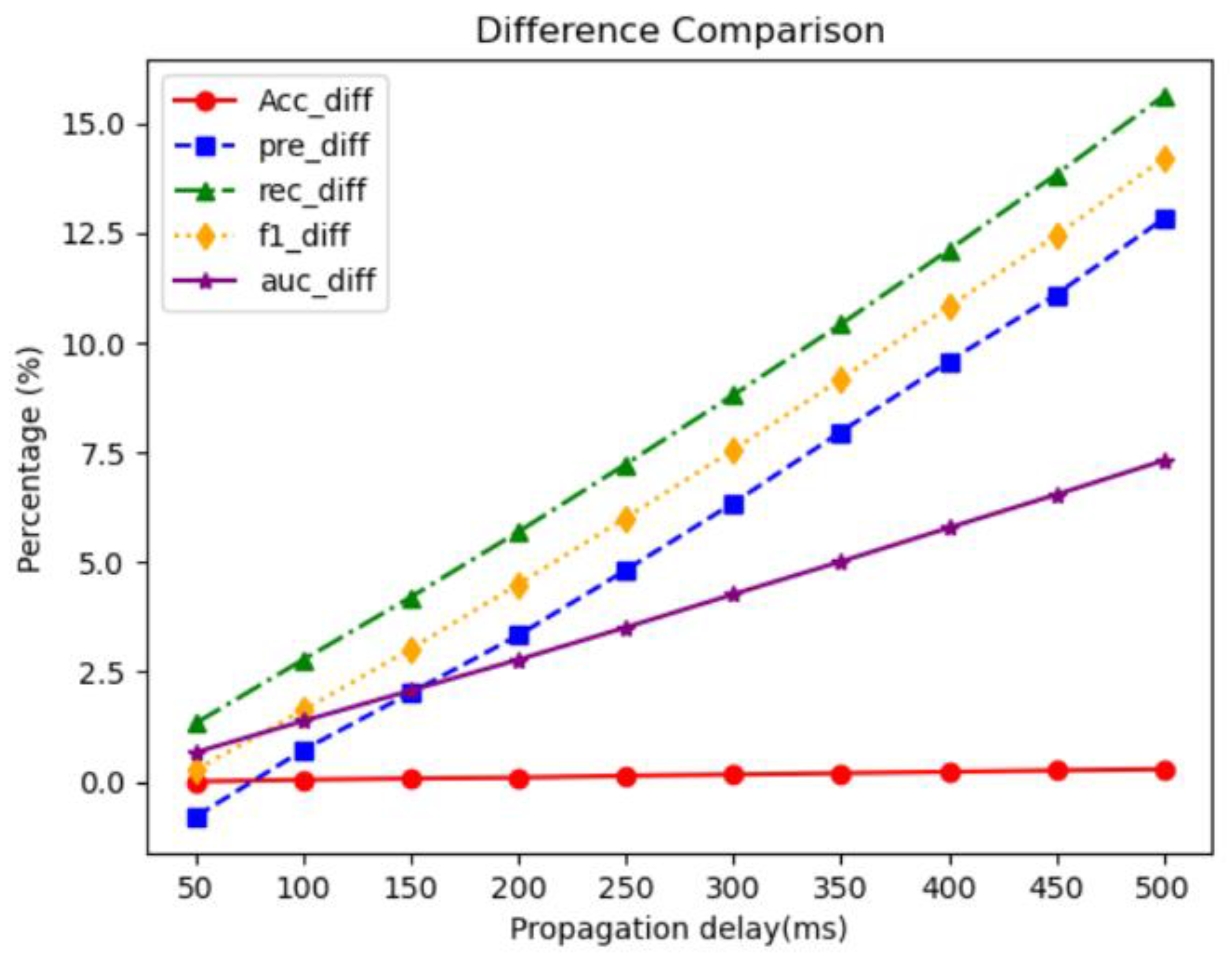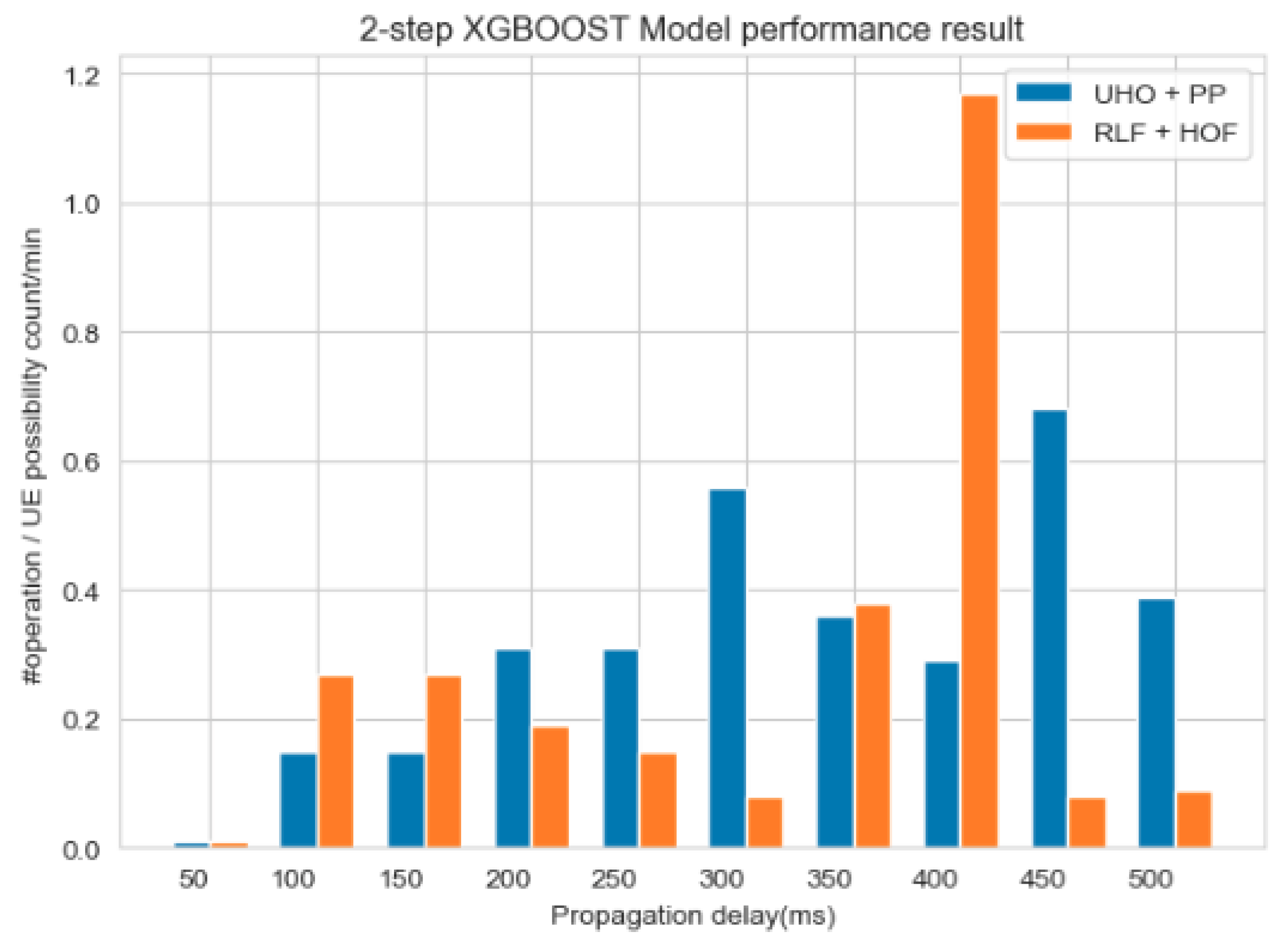1. Introduction
In existing networks, communication between User Equipments (UEs) is accomplished through terrestrial base stations. However, this communication service is limited to the coverage area of the installed base station, and it cannot be provided outside that region. To address these limitations, a communication method called Non-Terrestrial-Network (NTN) 3GPP was proposed. NTN utilizes satellites capable of providing communication services across all regions, enabling coverage in areas not served by ground-based base stations. NTN leverages satellites, High-Altitude Platforms (HAPs), and Unmanned Aerial Vehicles (UAVs) as airborne mediums to offer services to users in locations such as airplanes, mountainous regions, and the sea, where traditional ground-based base stations cannot provide coverage [
1,
2]. The use of diverse types of satellites and HAPs is expected to foster connectivity in various industries, including scenarios involving natural disasters, seaborne base stations, and construction sites [
3].
Various scenarios utilizing NTN have been presented. Among them, an air-to-ground system has been proposed, enabling communication with airborne objects by utilizing ground networks while also providing ground network services in the air [
4]. Additionally, research is being conducted on the NB-IoT (Narrowband Internet of Things) that supports IoT applications within NTN, as well as eMTC (enhanced Machine Type Communication) [
5]. Over time, NTN is evolving to offer communication services or an expanded range of communication services to the public based on 5G technology, and numerous studies are currently underway in this domain. Covered also are the development of 5G NTN standards and the challenges of satellite 5G network integration technology and an overview of the state of the art in LEO satellite access [
6,
7]. There are numerous factors to consider when applying NTN. It should be capable of supporting terrestrial networks and be adaptable to various industries [
8]. Moreover, as technology progresses, studies are being conducted to incorporate Artificial Intelligence (AI) and Machine Learning (ML) models into communication systems [
9]. Several papers have explored the application of ML models in different fields relevant to communication systems [
10,
11]. Additionally, research is underway on AI/ML management in communication systems, including methods that leverage data exchanged during handover processes [
11,
12,
13,
14].
Several considerations arise when high-altitude satellites or UAVs are utilized to provide services to ground terminal nodes. Among them, the handover of the control plane is crucial for ensuring service continuity when a User Equipment (UE) moves from one cell served by a base station to a neighboring cell, or transitions from a receiving base station to a neighboring base station’s cell [
15,
16]. However, applying the handover metric used in terrestrial networks to Non-Terrestrial-Network (NTN) poses a challenge. In a Terrestrial Network (TN), the distance between the UE and the base station is relatively close, allowing handover indicators to be measured at relatively short distances and used for triggering handovers. In contrast, in the NTN system, satellites can be positioned at altitudes ranging from 2000 km to 35,786 km above sea level, requiring considerably longer distances than in TN [
17]. This difference in distance poses a significant challenge in developing handover mechanisms and metrics that are suitable for NTN’s unique characteristics.
Furthermore, satellites provide services while moving at a constant speed in the Earth’s orbit. Due to this constant motion, the User Equipment (UE) receiving service from such a satellite experiences frequent handovers, even if it remains stationary. This frequent handover leads to a degradation in communication service quality and poses challenges in ensuring continuous service quality. Additionally, when a high-altitude satellite provides service to a ground-based UE, a propagation delay occurs. In the case of Measurement-Based Handover Triggering, the propagation delay is based on the measurement result obtained from the reference signal at the satellite’s location. However, there exists a disparity between the measurement result obtained when the satellite is located and the result obtained at the reference point after accounting for the actual propagation delay. This discrepancy adds complexity to the handover process and necessitates careful consideration to mitigate its impact on communication system performance. Because of reasons, several papers have presented diverse approaches to address the NTN handover problem [
18,
19,
20,
21,
22]. These include proposing a graph framework and determining an optimal path, optimizing the handover process through MIMO (Multiple Input Multiple Output) technology, maximizing benefits by defining a utility function for mobile terminals, detecting load during the handover process and employing channel reservation optimization strategies, as well as introducing papers focusing on optimizing handover by enhancing the random access process.
To address the challenges in servicing ground terminal nodes at high altitudes, this paper considers the realistic scenario, taking into account the propagation delay that occurs at high altitudes, and proposes a handover triggering technique based on machine learning to predict the distance and altitude angle between the moving satellite’s cell center and the User Equipment (UE). The XGBOOST model, an ensemble algorithm based on gradient boosting, is utilized to predict the distance and elevation angle between the UE and the cell center after the propagation delay based on the UE’s location. Using a model that determines whether to trigger handover based on the predicted location can enhance the handover function to ensure continuous service provision at high altitudes and achieve more accurate handover triggering.
Section 2 of this paper provides a comprehensive review of the related literature, including performance measurement of NTN handover and evaluations of proposed handover triggering techniques based on mobility enhancement by 3GPP.
Section 3 describes the proposed system model, the dataset used for experimentation, and the implementation methodology.
Section 4 elaborates on the performance evaluation metrics used to assess the research results and presents the outcomes of the model’s performance. Finally,
Section 5 offers a concluding summary of the paper.
2. Related Work
2.1. Literature Review
Experiments were conducted in several papers to evaluate 5G-based handover performance in NTN. The performance of terrestrial and non-terrestrial networks was compared using conditional handover. Most of the studies were conducted based on CHO [
23,
24,
25]. Handover performance was measured in the FR2 band frequency band. The performance measurement comparison target was compared with the terrestrial network, and the KPIs used are shown in
Table 1 [
23].
HO Success means whether the UE succeeded in handover to the target cell, All Mobility Failures means whether HOF occurred from the source cell to the RLF or target cell, and Ping Pong (PP) means whether or not the UE returned to the source cell within 1 s from the last handover.
Table 2 shows the parameters used in the experiment [
23].
In paper [
23],
oprep means execution when the source cell differs from the target cell by the corresponding value, and
oexec means execution when the target cell differs from the source cell by this value. As a result of the experiment, the CHO HO Success value was superior to BHO when the UE’s moving speed was 30 km/h or higher. It was confirmed that the higher the
oprep value, the better the HO Success. However, when a large
oexec value was given, the HO Success value was low due to the late handover execution and the PP significantly decreased. If the
oexec offset is large, performing handover execution in a situation where the target cell signal strength is worse than the currently serving cell will lead to a handover, which lowers the handover success rate. Conversely, when the
oexec value is relatively small, the signal strength of the target cell is good, which increases the handover success rate. However, the closer the handover is to the target cell, the better the signal strength of several nearby cells, which increases the probability of PP.
In addition, a CHO-based UE-oriented handover scheme has been proposed. There will be too many resource requests to handle the handover of all UEs in the satellite, and a technique for handling the process in the UE has been proposed to distribute it. In addition, the handover between several candidate satellites rather than one satellite was dealt with, and the experiment was conducted by dividing the number of candidate satellites, elevation angle, signal strength, and service time-based handover [
24]. Among the proposed methods for mobility enhancement in 3GPP Rel in 16, research has also been conducted using the location-based handover triggering technique. The cell radius is defined as
Rc and
Rc− and
Rc+ are defined as conditions for location-based handover triggering (LHT) to occur, limiting handover triggering in the range not included in the corresponding section and, at the same time, satellite service according to time. A method using the rate of change of the distance from the center of each cell was also proposed.
Table 3 illustrates the parameters used in the experiment [
25].
The paper assumed HOM as 0 db and TTT as 0 ms. When comparing the performance of Measurement-Based Handover Triggering (MHT) and Location-Based Handover Triggering (LHT), it was confirmed that LHT performed better.
In order to solve the problems existing in NTN with ML, methods applied in 3GPP Rel in 18 and several papers are proposed [
9,
10,
11,
12,
13,
14]. There are papers applying machine learning (ML) to improve performance in NTN. In [
10], the ML techniques applied to each situation in NTN are summarized. For example, Reinforcement Learning (RL) Q-Learning is used to improve moving cell connectivity, and trajectory optimization [
11], and Mobile Edge Computing (MEC) and RL are used to efficiently provide services to unserved areas. Application example, RL example for throughput increase, RL for secondary link backup, Bidirectional forwarding detection (BFD), Long term-short memory (LSTM) and Neural Network (NN) application example, multi-layer for disaster relief Perceptron (MLP)—Examples of applying LSTM and Deep Q-Learning for Broadcasting/Multicasting are summarized. Most of the problems given in NTN showed an approach to solve with RL by defining the target to be optimized as an object function [
26,
27,
28,
29]. In addition, examples and architecture of MEC offloading for user data traffic in NTN were shown [
29,
30].
2.2. Non-Terrestrial Network Overview
Existing terrestrial 5G networks provide communication services around installed base stations. Telecommunications companies want to provide services with wide coverage at low cost. However, in order to cover all domestic terrestrial networks using terrestrial networks, terrestrial cell coverage must be installed without any vacancy. NTN provides a wide range of coverage at high altitudes and can provide communication services in mountainous areas where ground networks are not installed, in the middle of the sea, and in airplanes. In order to apply NTN with these advantages to the communication system, 3GPP listed and suggested solutions to problems for providing NTN services from an overall overview of NTN through Releases 15, 16, and 17. In order to actually service and commercialize using NTN, several papers have been proposed to solve the problems presented by 3GPP. In this section, representative contents of NTN are summarized.
In 3GPP Release 16, scenarios defined by dividing GEO and LEO into transparent payload and regenerative payload were described. Each scenario provided by NTN is shown in
Figure 1 and
Figure 2 [
31].
There are several definitions of satellites according to altitude.
Table 4 is a representative satellite.
Several NTN network elements exist, and the interface between each network element is shown in
Table 5.
Table 6 is an NR-RAN-based NTN architecture proposed based on the interface of
Table 5.
The scenario presented in TR38.821 of 3GPP Rel 16 provides services at high altitudes. Thus, there is a delay issue according to distance.
Table 7 is a table showing overall values corresponding to the scenarios defined in
Table 4.
Unlike the terrestrial network, NTN propagation delays for each scenario in
Table 7 cause delays in the measurement report, handover command reception, and handover request/ack in the handover process. In order to trigger handover, a measurement report is transmitted to the receiving cell or gNB when various measured values satisfy the criteria. However, the NTN environment that communicates at high altitudes cannot trust the validity of the measured values.
Figure 3 shows the difference in signal attenuation received at the cell center and cell edge in terrestrial and non-terrestrial networks.
In the left image depicting the terrestrial network, there is a noticeable difference in signal strength between User Equipments (UEs) located close to the gNB (ground-based station) and those located farther away. However, in the right image representing the Non-Terrestrial Network, the signal strength difference between the UE at the cell center of the NTN gNB and the UE at the cell edge is not clearly evident. Therefore, using signal strength as a handover triggering method in NTN may lead to inaccuracies. To address this issue, the corresponding TR 38.821 suggests various handover triggering methods available in NTN, which go beyond relying solely on signal reception sensitivity.
Table 8 presents the proposed handover triggering methods in NTN.
TR 36.763 describes the IoT NTN scenario. Among the scenarios of 3GPP TR 38.821 Rel 16, a transparent payload scenario is assumed. The difference from the scenario of 3GPP TR 38.821 Rel 16 is that the Medium Earth Orbit (MEO) scenario is added. MEO is a satellite located between the LEO altitude range and the GEO altitude range [
32]. IoT NTN must be able to support EPC and 5GC. And it is assumed that the UE can support Global Navigations Satellite System (GNSS).
Table 9 summarizes the contents of the delay issue in LEO and GEO. IoT NTN considers the MEO scenario. Therefore,
Table 9 summarizes the MEO delay and related parameters.
loT NTN assumes NB-IoT and eMTC support. In the case of NB-IoT, if it is out of cell coverage provided by NTN, it is treated as Radio Link Failure and the UE attempts RRC connection for re-establishment. In the case of eTMC, there are issues such as delay for handover signaling processing, measurement validity, frequent handover, dynamic neighbor cell list, handover of a large number of UE, and impact of propagation delay difference in measurements such as NR NTN.
2.3. Handover
The terminal node is connected to the base station that has expanded the cell site at the current location and uses the communication service. Connected terminal nodes may stay in one location. However, there are cases where it continues to move. In this case, the location may be moved from a source cell to an adjacent cell, or the adjacent cell may be a cell of a base station other than a cell expanded from one base station. Handover occurs when moving from one cell to an adjacent cell. Handover is a process to ensure continuity of service.
Figure 4 shows a case in which handover occurs as the user moves to an adjacent cell as the user moves.
There are several criteria for handover triggering. Representative A1–A6 events among them are shown in
Table 10.
Based on the events in the table above, handover is performed from the receiving cell to the adjacent cell. Efficient handover minimizes dropped calls or loss of data transmission, and mobility management allows users to move seamlessly while maintaining a reliable connection.
Handover works differently in different situations. There are several cases such as handover between cells within one base station, handover between base stations, and handover from 5GC to EPC. An inter-cell handover process within one of the base stations will be described. Conditional Handover (CHO) is a handover that improves the handover process performance of Baseline Handover (BHO). Handover process triggering can be determined by using additional criteria. In addition, configuration information of an adjacent cell list capable of handover other than RACH to the target cell after the RRC reconfiguration step is stored in the UE. Then, if the conditions for handover triggering are satisfied, the handover process is performed on the target cell. Therefore, CHO can ensure more robust connectivity and continuity of service.
Figure 5 shows the flow of CHO.
The UE measures the criterion of the measurement index. If the standard of the measurement index is met, a measurement report is transmitted to the source cell. CHO is requested for target cells that can handover the source cell. The candidate target cell list transmits a handover request ack message to the source cell. Then, the source cell transmits an RRC Reconfiguration message including the configuration of CHO target cells to the UE. The UE transmits an RRC Reconfiguration Complete message to the source cell. After receiving the CHO configuration, the UE maintains a connection with the source cell and determines CHO execution conditions for the target cell list. Once a target cell from the target cell list satisfies the condition, the UE detaches from the source cell, applies the configuration of the cell that meets the condition, proceeds with synchronization with the target cell, and transmits the RRC Reconfiguration Complete message to complete the RRC handover procedure. The UE releases the stored CHO configuration after successful completion of the RRC handover procedure.
5. Conclusions
The purpose of providing communication services through satellites is to extend coverage to areas that cannot be reached by terrestrial networks. As a hyper-connected era is anticipated in the future, Non-Terrestrial Network (NTN) must ensure continuous and reliable communication in all regions above a certain altitude. While there are various challenges in applying NTN, the issue of mobility in connected mode is of utmost importance. Users may experience significant inconvenience if communication services are interrupted, emphasizing the critical need for uninterrupted connectivity. Satellites at high altitudes provide services to ground terminal nodes, but due to the long distance, there is a time delay for radio waves to reach the terminals. This temporal difference becomes more significant at higher altitudes. Moreover, Low Earth Orbit (LEO) satellites, operating at relatively low altitudes, move at high speeds compared to ground-based terminals, posing a challenge to maintaining communication continuity. Communication quality is bound to deteriorate even when satellites operate at higher altitudes. Our study conducted experiments in an environment closer to real-world communication situations by considering propagation delay, an actual environmental variable, rather than assuming only ideal conditions. In an actual NTN environment, Line-of-Sight (LOS) conditions may not always prevail, introducing more unpredictable variables. Obstacles between communication terminals, unexpected orbit deviations, and changes in channel quality over time are likely occurrences. To address this, this paper proposed a two-step XGBOOST model that compensates for propagation delay. The two-step XGBOOST model demonstrates superior performance across most altitude ranges compared to the existing handover triggering method based on New Radio (NR) that does not consider propagation delay, ensuring communication continuity with moving satellites. The handover triggering experiment considering propagation delay yielded favorable performance, especially from the 50 ms section. Although there is a slight difference in precision, the f1-score, which represents the overall model performance, shows better results. Thus, the proposed model exhibits enhanced handover triggering performance not only in LEO NTN and Medium Earth Orbit (MEO) NTN but also across the entire altitude range.
